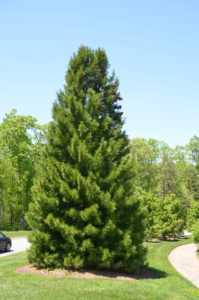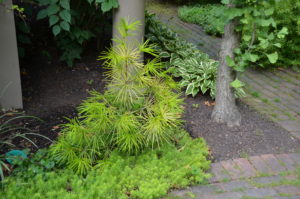Japanese Umbrella Pine (Sciadopitys verticillata) is a prized ornamental evergreen (USDA hardiness zones 5b -9). It is not actually a pine. The only species within genus Sciadopitys, this conifer dates back to the dinosaurs. Umbrella pine is a mid-sized landscape tree with several fine attributes: 1. glossy green long narrow needles arranged like the spokes of a wheel; 2. peeling reddish brown bark; and 3. conical form.
In its early years after planting, umbrella pine is a notoriously slow grower. Eventually, it reaches 30 to 40 feet in height and 20 feet wide. Specimens 70 feet tall are not unusual. Shedding reddish brown bark is noticeable on mature trees. Umbrella Pine prefers full sun with light shade around mid-day. Plant the tree in humus-rich, moist, well-drained soil with slightly acidic to neutral pH. Their long rigid needles, along with a sturdy limb structure, allow the tree to withstand heavy snow and ice loads.
Several forms, including variegated, pendulous, columnar, and dwarf cultivars, along with striking foliage are available at specialty conifer nurseries.
Four Unusual Forms of Umbrella Pine:
‘Gruene Kugel’ – slow-growing compact form from Germany (30 inches x 18 inches in 10 years); rounded form when young, develop slowly into a small compact tree with glossy deep green foliage year-round.
‘Mr. Happy’ – upright coniferous tree with lush dark-green needles and /or clear yellow variegation. According to Buchholz & Buchholz Nursery in Gaston, OR, needles may be entirely green or entirely yellow or variegated half-and-half. It prefers sun/partial shade in well-drained soil; 5 feet tall x 3 feet wide in 10 years. Zone 4
‘Joe Kozey’ grows tall and very narrow at 20 feet high and 6 feet wide. Needles are held more tightly to the trunk than other types. At maturity, this slow-growing variety becomes a large, spire-like tree.
‘Picola’ – a dwarf, conical selection with short, 2 inch (5 cm) long, shiny dark-green needles. After 10 years years of growth, a specimen will stand only 30 inches (80 cm) tall and 15 inches (35 cm) wide, suggesting an annual rate of growth of 2.5 inches (8 cm).



 Posted in
Posted in 
